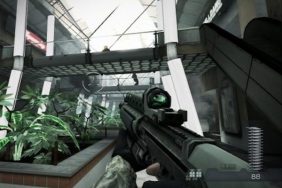One of the best ways I’ve heard hipster described is one who obsesses over that which is perceived as genuine, be it a type of music, a trend, or even the entire city of Rapture. There is never a shortage of old school analogue to be admired by the skinny jeaned. Even the fact that Bioshock was never “real”, didn’t seem to matter, the franchise earned its loyal fans who safe-guarded its reputation. Alien: Isolation may be on trajectory to earn some of its own. Alien, Ridley Scott’s seminal classic from 1979, is more than just an inspiration for the game, it’s more like a mission statement that The Creative Assembly vows not to break: no tech, no dialogue, not even the pacing betrays the spirit of the late seventies film. It feels authentic in every sense of the word.
Reuniting the full cast for the first time since the original film is one powerful way Alien: Isolation commits itself to authenticity. Even Sigourney Weaver signed on, reprising her role as Ripley. The rest of the Crew Expendable from the Nostromo include: Tom Skerrit (Dallas), Harry Dean Stanton (Brett), Yaphet Kotto (Parker), Veronica Cartwright (Lambert), and Ian Holms as robot Ash. Newcomer Andrea Deck plays Ripley’s daughter Amanda whom the player controls. Remember Ripley tearfully looking at a photo of an old woman in the extended cut of James Cameron’s sequel, Aliens (circa 1986). That was Amanda. The relationship Ripley ends up having with Newt highlighted the mother-daughter moments she missed as a result of her 57-year cryosleep. Set 15 years after the events of the first film, Amanda’s piecing together just what exactly happened to her mom. Amanda has been transferred to the space station Sevastopol to find the flight recorder of the Nostromo where an alien – just one – has infested the station. Since you’re not in the action-packed world of Aliens, dealing with a single H.R. Giger designed monster will be plenty. Trust us.

Alien: Isolation has a cast that Alien fans are excited about.
As a template, Scott’s direction in Alien was already very shooter-like. This is years before Doom would blast open a hole for the FPS genre to follow. Opening with the stillness of a spaceship whose crew is slowly awakening, there were plenty of shots that felt immersive the way shooters do now, like lurching down hallways, or panning across objects in motion. All of it done in a seductively voyeuristic fashion. Remember all those buttons and switches just begging to be tinkered with? Let the tinkering commence.
There’s a lot here to explore, but like Bioshock, the game is really all about convincing the player that its fictional world is immersive. Unlike the heroes in that game, Amanda isn’t designed as an all-powerful, plasmid-addicted badass because at it’s heart this is survival horror. Sure, the flame-thrower Dallas uses in the film is at your disposal, but remember how ultimately ineffective that weapon turned out to be? Still, the first time I lit up the Alien was thrilling as it’s slimy body quivered violently, just like in the film.
Then there’s that piercing sound. I was overjoyed (and terrified) the first time I heard the shrill, angry scream the Alien makes. The later movies in the series would ditch that scream in favor of a more booming, albeit more generic lion roar sample. The scream is back in Isolation. So too are the somewhat muffled, mechanical sound effects that filled Alien and to a lesser degree Blade Runner. That ‘thuka thuka clap’ reeks with a late 70s/early 80s vibe. That’s the kind of detail on display on a single play through of the game.
The exchanges between characters promises to be akin to the laid back tone in Alien. The hairstyles on the guys will be more shaggy, less coiffed. One of the best aspects of the series has been the focus on working-class, everyday folks. Alien had Parker arguing with Ripley about overtime. Aliens had the pumped up attitude of the marines. That spirit here is as well, which is great since too often games rely on characters that are super smart as well as super brave.
In keeping with the lo-tech art direction the game features no on-screen heads-up display, so the player must use their inventory to acquire information, like bringing up the motion tracker to track the Alien as it lurks the halls. The motion tracker triggers a depth of field effect so you can’t focus on the tracker and what’s in front of you at the same time. The device is about motion. No more, no less. So if the Alien stops to try and sniff you out you’re screwed.

The Alien is intelligent, so you’ll have to outsmart it.
The game has a crafting system, which allows the player to make weapons and tools to defend themselves. Like Daylight, objects appear in randomized locations, forcing players to explore the ship to find them on each play through, as opposed to memorizing the locations. Players will also encounter computers and other devices that can be hacked to access information, which is similar to the old scrubbing of videotape. Amidst all that tech (there will be weapons more powerful than the glorified torch) is the lingering feeling that at any moment any item might breakdown, or run out of ammo real fast. Funny how the more imperfect things are, the more it’s believable… and the more we long to find a locker to hide in.
Though the 70s feel will hopefully feel as natural as wide jeans, that much attention to detail was no easy feat. The game’s artists studied Ron Cobb’s original concept art. Some changes needed to be made though. While the alien was designed to look as close to Giger’s original as in the first film – including the semitransparent head with visible skull underneath – changes had to be made. The Alien in Isolation sports recurved legs as opposed to the more humanoid ones the monster had in the original film. This was to give the it a walk pattern that would hold up to scrutiny as players repeated sections. Also, The Creative Assembly created nearly 80 different sets of animation for the Alien. 20th Century Fox provided them with three terabytes of archived data from original film, including notes on prop and set design, behind the scenes photos, videos, and the film’s original sound effect recordings. Among the source material provided by 20th Century Fox, was the film’s original soundtrack, to which the developers re-recorded several of the original cues with a full orchestra, including some of the musicians who worked on the first film’s soundtrack. The game features a dynamic sound engine that can change based on the players actions, such as whether they are hiding or fleeing from the Alien.
If Alien: Isolation, which comes out October 7th, is as big of a hit as it appears it will be, there will more adventures with the spawn of Ripley in deep space. Sadly, she’ll probably never own a smart phone.







